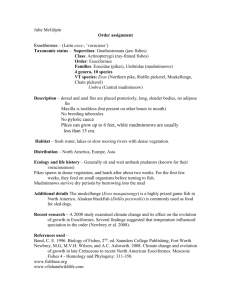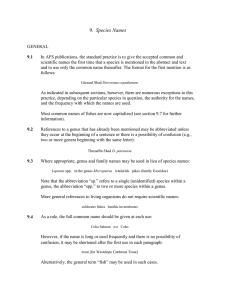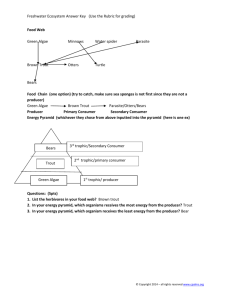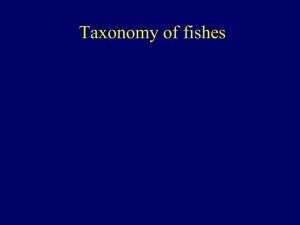Lab7_2006
advertisement
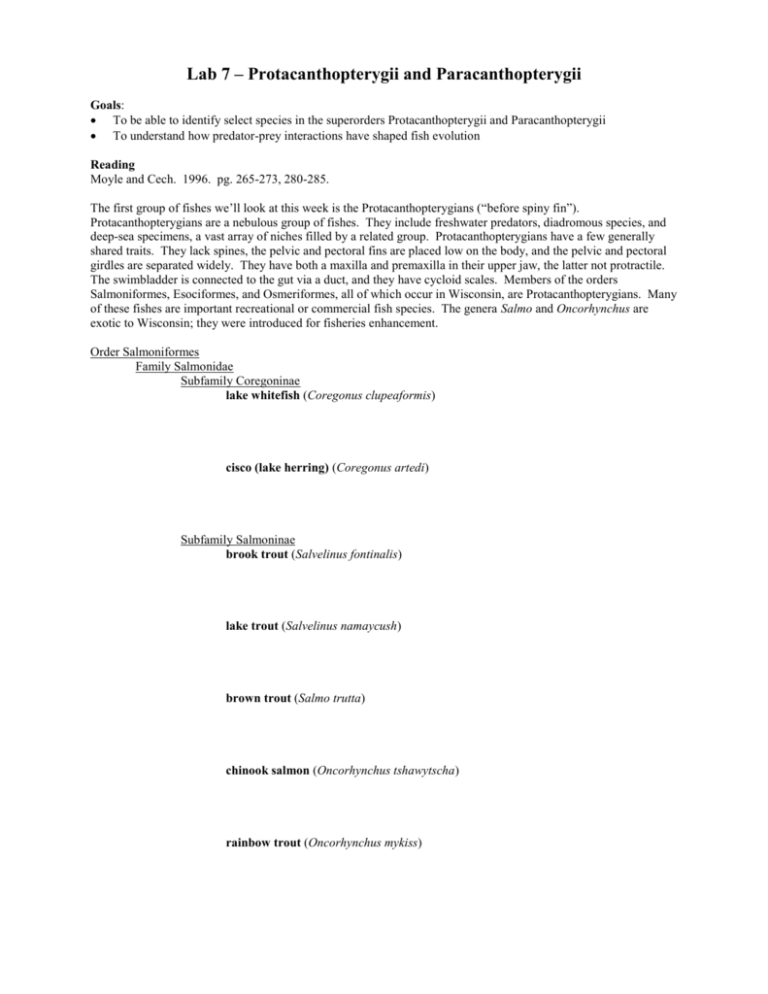
Lab 7 – Protacanthopterygii and Paracanthopterygii Goals: To be able to identify select species in the superorders Protacanthopterygii and Paracanthopterygii To understand how predator-prey interactions have shaped fish evolution Reading Moyle and Cech. 1996. pg. 265-273, 280-285. The first group of fishes we’ll look at this week is the Protacanthopterygians (“before spiny fin”). Protacanthopterygians are a nebulous group of fishes. They include freshwater predators, diadromous species, and deep-sea specimens, a vast array of niches filled by a related group. Protacanthopterygians have a few generally shared traits. They lack spines, the pelvic and pectoral fins are placed low on the body, and the pelvic and pectoral girdles are separated widely. They have both a maxilla and premaxilla in their upper jaw, the latter not protractile. The swimbladder is connected to the gut via a duct, and they have cycloid scales. Members of the orders Salmoniformes, Esociformes, and Osmeriformes, all of which occur in Wisconsin, are Protacanthopterygians. Many of these fishes are important recreational or commercial fish species. The genera Salmo and Oncorhynchus are exotic to Wisconsin; they were introduced for fisheries enhancement. Order Salmoniformes Family Salmonidae Subfamily Coregoninae lake whitefish (Coregonus clupeaformis) cisco (lake herring) (Coregonus artedi) Subfamily Salmoninae brook trout (Salvelinus fontinalis) lake trout (Salvelinus namaycush) brown trout (Salmo trutta) chinook salmon (Oncorhynchus tshawytscha) rainbow trout (Oncorhynchus mykiss) Order Esociformes Family Esocidae grass pickerel (Esox americanus vermiculatus) northern pike (Esox lucius) Family Umbridae central mudminnow (Umbra limi) Order Osmeriformes Family Osmeridae rainbow smelt (Osmerus mordax) Paracanthopterygians (“like spiny fin”) are the first group of fishes we’ll look at that possess true spines. They are a weakly defined group of fishes, lumped together because of the morphometry of their skeletons in the caudal region and holes in the skull for cranial nerves. Most members of this group are nocturnal or deep sea benthic marine fishes. Only 20 of 1,200 species live in freshwater. Paracanthopterygians in general, but not always, possess true spines, elaborate and protractile premaxillas, ctenoid scales, pelvic fins in the thoracic or jugular position. Gadiformes, or the cods, make up some of the most important commercial marine fisheries in the world. In Wisconsin, we only have three native Paracanthopterygians. Order Percopsiformes Percopsidae trout perch (Percopsis omiscomaycus) Aphredoderidae pirate perch (Aphredoderus sayanus) Order Gadiformes Lotidae burbot (Lota lota) QUESTIONS (Answer in a few sentences and turn in next week) 1. Look at the fins of fishes in Salmoniformes and Esociformes. Describe the most likely feeding behavior of a fish from each group, given their fin morphology and placement. 2. List two traits that clearly distinguish a cisco (Coregonus artedii) from an alewife (Alosa pseudoharengus). 3. What traits on the trout perch would be considered derived, compared to a brook trout? What traits on the trout perch could be considered ancestral, compared to the pirate perch?
